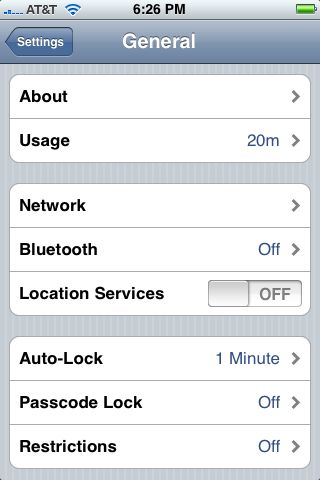I turned off the iPhone 3G’s assisted GPS feature (Location Services) for the past two days and noticed a huge battery life improvement. My 3G’s battery life was not too bad to begin with. It seemed to last all day even with GPS turned on. But, with GPS turned off, battery life looks much better.
Blog
-
Podcast w/Frank McPherson Talking About His T-Mobile G1 Experience Available
I had a great discussion with Windows Mobile expert Frank McPherson (PocketPCHow2.com) about his experience using the T-Mobile G1 (Google Android) smartphone since its release. You can find the podcast (with embedded web player) here:
-
Why I Disagree with TechCrunch’s 3 Anti-Netbook Points
TechCrunch’s Michael Arrington makes some interesting points in…
Three Reasons Why Netbooks Just Aren’t Good Enough
I think I agree with his basic point that netbooks are NOT notebook replacements. But, I disagree with the rationale given. Here are his main points and my issues with them.
1. Arrington says netbooks are underpowered: The question is what does he mean by underpowered? Underpowered for what? Video processing? Yep. Heavy PhotoShop use? Yep. 3D graphics intensive games? Yep, again. But, what about what netbooks are presumably designed for: Web browsing, email, word processing, small to medium size spreadsheets, etc. The netbooks I’ve tried perform these tasks just fine. Quite frankly, the Atom processors in the Acer Aspire One and Asus Eee PC 1000H I have are plenty fast compared to desktop and notebook PCs I used a couple of years ago back when I was using Windows XP and Linux. Oh wait, what am I running today on my netbooks? Hey, I’m still using Windows XP and Linux. Does that mean all the desktops and notebooks I used prior to the emergence of the Core 2 Duo were unacceptable too? Perhaps, but I do not think so.
2. Arrington says netbook screens are too small for effective web surfing: The TechCrunch piece keeps talking about 7 inch screens. Except for the first Asus Eee PCs that came out, most current generation netbooks (starting around this past summer) comes with 8.9 inch or 10 inch displays. And, the resolution has gone up from 800×400 to 1024×600. Yes, 600 vertical pixels seems a little low to me sometimes too. But, I don’t find myself scrolling horizontally with a 1024 wide display. My Asus Eee PC 1000H with its 10 inch screen is the netbook that is on the road (and air) with me all the time these days. It is more than fine for web browsing. And, yes, I’m using it right now to write and edit this blog entry (which is getting kind of long).
3. Arrington says netbook keyboards are too small for effective typing: Again, it depends on which netbook you are using. Yes, the original Asus Eee PCs with the 7 inch screen and proportiately small keyboards are too small for many adult hands. But, I’ve found the keyboard on the Acer and Asus netbooks I’ve used for the past couple of months quite good for typing. I can touch type on both keyboards and maintain what seems to me to be a normal touch typing speed.
So, while I don’t recommend rendering video, running PhotoShop with large images, or working on a spreadsheet with thousands of rows on a netbook, I’ve found it perfectly fine for what it was designed for: Web browsing, email, light image editing (I use The GIMP), and light to medium word processing and other office document work.
-
MobileAppsToday/MobileDevicesToday Podcast #1
Michael Gartenberg (Jupitermedia VP & Editor of MobileDevicesToday.com and I (I’m editor of MobileAppsToday.com) recorded our first joint podcast. I posted it up yesterday. You can hear it using the embedded player above. I posted show-notes (of sorts 🙂 over on MobileAppsToday.com.
-
Work at home & on the move? Twitter is my Virtual Water Cooler
I’ve been a full-time blogger for 3 months now (check out my day job blog MobileAppsToday.com). I’m pretty happy to be working alone and uninterrupted most of the time. But, it is nice to interact with real people now and then too. Although I used Twitter before making this job-lifestyle change, it has become invaluable as my virtual water cooler weather working at home or on the road (with netbook and smartphone(s) in tow).
I maintain a locked personal Twitter account to talk/tweet with people I actually know for this purpose. It was one of the smartest things I’ve done, I think. I also have a public Twitter account to mostly talk about my work and tweet with people I don’t know personally. You can find this public account at:
-
T-Mobile G1 == Zune == Rodney Dangerfield?
Ha! I noticed Michael Gartenberg, who is my blog-neighbor MobileDevicesToday (I edit MobileAppsToday), asked…
Is the Zune the Rodney Dangerfield of technology?
Then, Roy Furchgott on The New York Times said…
So, I guess…
T-Mobile G1 == Zune == Rodney Dangerfield
